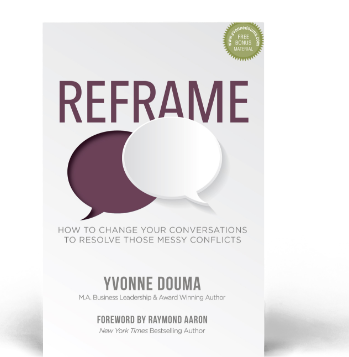Teaching clients how to have difficult conversations is one of my favourite things to do. There are always so many “aha” moments and practical advice my clients can apply immediately when they learn actual strategies for managing difficult conversations.
Can you relate to this story?
You love your job and, for the most part, you like your colleagues. But whenever you start talking in a meeting, your marketing counterpart rudely interrupts and starts to talk over you. She has a habit of never letting you finish your point.
Up until now, you didn’t want to say anything because you are new to the company.
However, you are starting to feel resentment towards her. You take pride in managing positive workplace relationships, yet you are afraid you will blow up at her the next time she interrupts you. So, you realize you need to have a difficult conversation with her. Now what?
If you can relate to this story, keep reading. We’re going to explore how critical it is to use effective communication to validate and understand your colleagues. And you’ll learn how to have a difficult conversation so you improve your relationships at work and at home.
What Is A Difficult Conversation?
In short, a difficult conversation is any conversation we are not looking forward to having.
Are you being bullied at work by a colleague? Is someone repeatedly getting in your face? Is your employee not measuring up? Has your boss been criticizing your work performance in public?
Difficult conversations are how you remedy these situations and improve your workplace relationships.
People often avoid having these conversations, but now is the time to get honest with yourself.
If you’ve ever been unhappy with a situation at work, and you knew the only way it would get better is if you confronted the situation head on—but still, you were too afraid—then learning how to have a difficult conversation will help you.
No worries. You are not alone. Our fear of conflict is often greater than our desire to resolve the situation, which is why many people stay stuck.
But what if you could learn how to communicate and have difficult conversations where both parties felt heard and respected? It would be game-changing, right?
Calm Down and Reflect So That You Can Get to the Truth
You need to mentally prepare for difficult conversations. If you don’t, you risk escalating the situation.
During a conflict, we can have one of two reactions:
Option #1: We can flip out and get angry right away, saying things that we later regret. With this response, we assume we have all the information we need to understand what happened and react. Our goal here is to persuade them that we are right and they are wrong.
This approach usually ends up in a painful conflict.
Option #2: We can stop and think about the situation and come back later when we are more calm. With this response, we have had time to think through some things. We are better able to provide a more thoughtful response. We assume each of us is bringing different information and perceptions to the table. Or goal is to explore each other’s stories to gain a deeper understanding of the problem, instead of being ‘right.’
Ask yourself: which option are you most likely to choose when you are upset? And which do you think is the better option?
What To Consider Before Having A Difficult Conversation

Don’t let it get to this – there ARE healthier ways to resolve conflict.
Your Intentions
We often assume we already know what the other person intended.
But if you actually know what the other person intended, then you must be either a world-class mind reader or psychic (and neither of these is likely!).
So, is it possible you don’t actually know what they were thinking and what their intentions were?
What’s important to share during your difficult conversation is the impact their actions and words have had on you. You will also learn what they were thinking and the effect you may have had on them.
Your goal should be letting them know how their behaviour impacted you, instead of making assumptions.
Who Is Responsible?
It’s difficult to admit when we are wrong. Whether it’s pride, ego, or a strong desire to protect our reputation, sometimes it feels more comfortable to assume the other person is wrong.
So we play the blame game, blaming everyone and anyone but ourselves when things go wrong.
When we approach conflict with this mentality, our goals are to get the other person to admit they were wrong, take responsibility, and make amends to us. But this approach does not work!
Just because we point the finger at them and say, “You did it!” does not mean they will own it. By responding this way to conflict, you are almost sure to push people away.
We can’t control other people. We can only control how we react to them.
Another approach is often taken by the type of person who hates conflict and does anything to avoid it. They often take responsibility to move on quickly. This approach is not healthy, either and it will leave us feeling like a doormat. We definitely don’t want that!
Instead, a thoughtful response to a difficult conversation would be to assume both parties have probably contributed to this mess. Therefore, it makes sense they both need to work to clean it up.
The goal, in this case, would be to understand how the actions of both parties produced this result. By doing this, the other person is more likely to work with you on a win-win solution instead of going into a defensive mode themselves.
Look within for Answers
Self-awareness is key to helping you prepare for your difficult conversation.
To prepare your mindset for the conversation, you need to accept the following:
- You will make mistakes
- Your intentions are complex
- You have contributed to the problem
Think back to a recent conflict you’ve had. How did the conflict start? Were you trying to change the other person?
If so, realize that people do not change unless they want to change. We can’t change other people. We can only change our reactions to them.
Ask yourself:
- How were you feeling inside?
- Did they attack who you believe yourself to be?
- What were your emotions?
- What was coming up for you?
- Did they attack your values or our identity?
- Is the sense of conflict inside only you?
To demonstrate this point, I want to share a personal story.
When my kids were all living at home, I remember I would blame others for my unhappiness. “If only my daughter would clean her room, or my son didn’t come home so late, or my husband listened to me or helped me around the house,” then all my problems would be over.
If only I would have learned what I am teaching you now, back then. My regrets would not be so big. There were many poor reactions, but the one saving grace for me was I went and apologized for my behaviour. There was a better way to address the situation, and I blew it.
I am super close with my kids today, and they say it’s because I took responsibility for any wrongdoing. We both acknowledged our distasteful reactions and looked at how we could do things better the next time.
Can you relate to my story?
How To Have A Difficult Conversation
OK, let’s assume you have explored what was happening inside of you, and you’ve done all of the internal work to mentally and emotionally prepare for the difficult conversation (good for you!).
You have also considered what may have been going on for the other side, and you feel confident you have the right attitude for an effective and productive talk.
Now we move onto the conversation itself.
To help illustrate how this can go, let’s look at an example
One of my clients, Sandy (not her real name), is a very popular councilwoman in a medium-sized city. She is kind and considerate, and she tries to take the high road in how she interacts with people.
Sandy does not get directly angry at people. Instead, she lets it fester when she gets home.
After experiencing a situation at work, which she described as the “straw that broke the camel’s back,” she called me. Sandy was ready to explode. She didn’t sleep well or eat well. Sandy became very cranky with her husband even though he is incredibly supportive. She began to withdraw and shut down, declining coffee dates from friends and no longer taking their dog for walks.
As we chatted, Sandy told me that another councilwoman, Janice (also not her real name), was being very passive-aggressive towards her in Council meetings. Whenever Sandy shared an idea or thoughts on a particular proposal, Janice would reply sarcastically. Janice’s body language was very harsh, as she would laugh, look at others and roll her eyes, look away when Sandy was talking, and even take her phone out every time Sandy had the floor.
Sandy felt her identity was being threatened. She started to feel like maybe this line of work wasn’t for her. Self-doubt began to creep in. Sandy wanted me to advise her on what to do. She asked, “How can I stand up for myself without making Janice feel defensive right away?
As we’ll cover below, Sandy’s situation is perfect for demonstrating how to have a difficult conversation.
Time, Place, Tone
First of all, let’s discuss the time, place, and tone for your difficult conversations.
Never confront someone in front of others or during a meeting, as this never ends well.
Instead, choose a private place where you can sit down. Select a date and time that works well for both of you (allowing enough time for you to both be heard).
Your voice should be calm and friendly, and the tone of the discussion amicable.
Using the scenario with Sandy, I suggested she approach Janice after the next meeting ended, and I recommended a way for Sandy to introduce the subject with Janice:
“Hey Janice, can I talk to you for a minute? I’ve been feeling a little confused lately. I have noticed whenever I have anything to say in council meetings, you seem disinterested. Can we go for coffee down the road? I really want to hear your perspective on this.”
Sandy might meet with some resistance at first. Since Janice is her peer, she may still get defensive and push Sandy further.
Most times, though, when you tell someone you want to hear their perspective on something, and especially if you offer them a free coffee, they will agree. After all, an invitation to a coffee date isn’t very threatening.
Focus On The Unbiased Version Of What Happened
It’s critical to stay as unbiased as humanly possible. Describe the behaviour or situation concretely and specifically, without blaming or negative judgment. Share your point of view as a third person would. Own your part. Use “I” statements.
Here’s how Sandy could kick off the difficult conversation:
“So, Janice, it seems as if you and I may have different perspectives on the ideas I had on the hospital renovation. You seemed angry and irritated. I realize I may have misinterpreted your actions in the meeting, so I really want to hear your thoughts on this. After I hear what you have to say, I will share a bit about what was going on for me. And maybe we can figure something out.”
Listen and Share Feelings
When having a difficult conversation, seek first to understand. Listen to the other person with no interruptions. Remember that feedback can be hard to take for anyone. Even the best conflict resolution consultant may find themselves defensive (been there, done that!).
Here’s what happened next with Sandy and Janice:
Janice didn’t quite know how to respond. She didn’t say anything in the meeting she was aware of, but Sandy was right. Janice disagreed with the hospital proposal, and she felt angry this proposal was even being discussed.
Sandy said, “I am not here to accuse or judge you. We are both entitled to our feelings on this. Please tell me what was going on for you.”
Janice then shared her ideas and talked about her feelings. Janice also told Sandy she had family issues she had been struggling with. Sandy was then happy to share her feelings. She realized her initial thoughts about Janice were not entirely correct. Sandy assumed Janice’s actions meant she knew everything going on for Janice. She was wrong.
Problem Solving Together
Many, many times, when you approach a difficult conversation like Sandy and Janice’s, you realize there are no problems at all. About 98% of conflict is miscommunication. Body language and tone of voice, and the misinterpretation of these critical factors, are often to blame (learn more about how your body language impacts your relationships at work here).
If there is indeed a problem, remember, this discussion is not only about your perceived disagreements. It is mostly to help identify how you can work together to solve the problem without disrespecting each other.
This is where you can say something like, “So how can we prevent this from happening again? I do not want us to be on opposite sides where we both dread going to our meetings.”
Again, always remember to speak in “I” terms. For example, “I want to ask what you think about it, and then I will tell you what’s happening for me. Then let’s see where we can go from there.”
Evaluate after a Few Weeks
After having the difficult conversation, it’s a good idea to foster the relationship by checking in to see if you are both okay.
I recommended Sandy go back to Janice after a few weeks to check in.
Sandy simply said, “Hey, Janice, let’s chat again.”
At this time, you can ask how things are going. Have things improved?
If all is good, make a note to talk in a few weeks again, and work to maintain the new positive relationship.
Create Healthier Relationships At Work

The more you deal with conflict in a healthy way, the more successful your team will be.
Blowing up in anger is never the solution. Instead, try to find healthy ways to discuss issues, as this will foster better relationships and help the workplace environment.
Additionally, the beauty of approaching difficult conversations in a mindful way is that when other people at work start seeing you do this, they start thinking, “Wow! She is so powerful. She dealt with that beautifully.” Respect from the rest of the team will become visible. And others will even start behaving in the same way!
By listening and engaging with a person, you can change how you react to them. You can mitigate conflict instead of avoiding difficult conversations, which leads to copacetic workplace relationships.
Once you communicate effectively to others about how their behaviour affects you, you will likely notice most of your conflicts are due to a misunderstanding. Your relationships will improve, just by being willing to listen and really hear the other person’s story and then go on to share yours.
Of course, I realize this may be easier said than done, especially if you’ve been avoiding conflict your whole life, or if your work environment is particularly toxic.
I work with both individuals and small business teams to help them sort through all their ‘stuff’ so they can reduce conflict and move on to making money. Reach out for a free discovery call.

